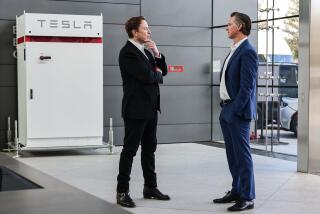Few Can Repeat : Business Whizzes: No Midas Touch
Howard Head might have been an athletic klutz, but his clumsiness didn’t stop him from revolutionizing two sports and making a couple of tidy fortunes for his efforts.
It all started when Head, an aerospace engineer, had trouble skiing and decided to remedy the problem by designing a pair of lightweight metal-and-plastic skis. For the next two decades, Head skis were considered among the best in the world and when he sold his company in 1969, Head walked away with $4 million.
After retiring from ski making, Head had time to discover his ineptitude for tennis. The result was the Prince tennis racket, the oversized paddle that netted Head $40 million when he sold the company four years ago.
Stories like Head’s, and all of the other reverential hoopla surrounding entrepreneurs these days, fuel the fairy-tale notion that most successful merchants are blessed with a Midas touch that turns all their ventures into winners.
Happily Ever After?
In reality, however, few companies live happily ever after--including those started by experienced, successful entrepreneurs.
Nolan Bushnell, the man who created Pong, the world’s first video game, and Atari Corp., the first-ever video game company, bombed out with Chuck E. Cheese’s Pizza Time Theater and Androbot, a robotic servant-toy. Harold Butler, the founder of Denny’s and Jojos restaurants, couldn’t make a go of Jean’s Donuts & Cookies or McGorky’s Seafood House. And James Ryder, founder of Ryder Trucks, saw his next company, Jartran truck and trailer rental company, founder before he sold out.
“It’s just as hard to hit the second home run as the first,” said George Crandall of Capital Venture Investors, a Sacramento venture capital investment firm. “There just aren’t that many entrepreneurs who have duplicated their success.”
But despite such skepticism, an increasing number of entrepreneurial winners are leaving their companies to start anew, including four high-profile businessmen within the last 18 months.
Computer for Students
Steven Jobs lost a bitter power struggle and left Apple Computer to start Next Inc., which plans to develop a new computer for college students.
Butler resigned from Naugles, the fast-food chain he helped build virtually from scratch, to devote full attention to his latest venture, Hershel’s Deli & Bakery.
Bushnell left the pizza arcade business to start focusing exclusively on Axlon, his new, high-tech toy company.
And in July, Mitchell Kapor, the founder of Lotus Development Corp., quit the company he turned into the nation’s top personal computer software house. Associates expect him to be involved soon in a new venture.
“Starting a new business is addicting,” said Lorraine Mecca, the founder and former president of Micro D in Santa Ana, one of the nation’s largest computer and software distributors.
Mecca, who left Micro D last year and is currently casting about for another venture from her Hawaiian retreat, argues that entrepreneurs basically can’t stop themselves from pursuing the excitement of creating something from nothing.
Many say they are motivated by a desire to market a “better mousetrap-type” product. For others the challenge is orchestrating the energies of a group toward a single goal. And still others, like those who climb mountains “because they’re there,” simply can’t pass up a business opportunity.
However, getting rich, perhaps the most common measure of success, does not seem to be a major motivation for the entrepreneur. “Making money is nice and I wouldn’t give mine back,” Mecca said. “But even if the business fails, an entrepreneur is still a success because the victory is the thrills, the making it happen.”
With or without the thrills, a business failure is still more likely than not.
High Failure Rate
According to the U.S. Small Business Administration, half of all new businesses fail within their first five years and eight out of every 10 close before celebrating their 10th anniversary. Although separate statistics aren’t kept on companies founded by repeat entrepreneurs, many experts believe their mortality rate is not significantly different.
Still, the rate is not much of a deterrence to the record-setting pace of new business starts in the United States. The Small Business Administration reports that 670,000 new businesses were formed last year, up more than 25% from the 533,000 in 1980.
While the agency doesn’t track entrepreneurs involved in their second or even third company, experts say their numbers have increased significantly in recent years for a variety of reasons, including the increasing amount of available venture capital and the growing acceptance of entrepreneurs who skip from venture to venture.
Venture capitalists and business school professors predict that in the coming years the ranks of the repeat entrepreneurs will continue to grow.
Yet, while opportunities combine to foster repeat tries, experts urge investors to use caution when it comes to betting on a successive success. In fact, some argue that the bigger the initial success, such as Jobs’ feat at Apple and Bushnell’s at Atari, the harder it is to repeat.
No Economic Motive
“If the entrepreneur has already been successful, there’s no absolutely economic motive the second time,” said Don Valentine of the so-called Silicon Valley, a venture capitalist for the last 15 years. “And the adage that starving artists and musicians do better work is true in business, too.”
Bushnell, who had two failures after his knock-’em-dead score with Atari, agrees that having “something to prove” helps fix an entrepreneur’s attentions on his business. And these days, after watching Pizza Time Theaters and Androbot collapse, the free-wheeling, self-described “creator” admits that he again has that something.
“Now I have to prove that I can hold onto a company over the $200-million mark,” he said, claiming that his latest venture is fast approaching that position. The challenge, as Bushnell’s detractors see it, rests in focusing the compulsive entrepreneur’s attention on a single effort and not allowing his love of publicity to get in the way of business operations.
“He’s caught up in his own ego,” chided Richard Buskirk, director of the entrepreneur program at USC’s School of Business Administration. “He didn’t even know enough about running Chuck E. Cheese to realize that you had to make a good pizza.”
Even Bushnell acknowledges that Pizza Time, which dropped from a $150-million-a-year company to Chapter 11 bankruptcy in just months, would have fared better if he had paid more attention to the business rather than trying to balance that act along with the management of about a dozen other embryonic high-tech companies.
World Wasn’t Ready
However, Bushnell claims that lack of management attention was not the problem at Androbot. In that case, he said, the world wasn’t ready for a $2,000 robot that was prone to getting stuck in corners and constantly posed a threat to the continued existence of prized breakable possessions. “He was too expensive for what he did,” he explained.
Butler, the restaurateur who has developed more than a dozen dining-out concepts in his 35 years in the business, said that whatever problems he has had re-creating Denny’s mega-success--and there have been several--he has brought on himself.
McGorky’s Seafood House, a short-lived dinner house, shut down after Butler discovered that Midwesterners weren’t as fired-up about mesquite-broiled fish as their fad-loving California counterparts. And Jean’s Donuts & Cookies flopped when its mainstay, a bite-size chocolate chip cookie, didn’t hit the spot with customers.
His latest problem was Naugles, a Mexican fast-food chain that was awash in red ink when he sold out last year. By most accounts, the chain was damaged by Butler’s attempt to rapidly expand it into a nationwide franchise from its Southern California base without sufficient advertising or regard for the difficulties of managing such a far-flung operation.
“An early success can bring entrepreneurial myopia,” said John Kao, a professor at the Harvard Business School. “Some guys may feel like they have a license for it.”
Seeds for Failure
Jean Deleage, a partner in the venture capital firm of Burr, Egan, Deleage & Co. in San Francisco, admits that he is particularly wary of advancing money to someone who has already been successful largely because first-time success can bring with it the seeds for future failure.
For example, Deleage said that with few exceptions, such as the 31-year-old Jobs, successful entrepreneurs aren’t spritely, energetic youngsters by the time they are on their second or third venture. “I have a rule,” Deleage said. “If they’re over 45 years old and have more than a $25-million net worth, I stay away.”
L.J. Sevin, the 55-year-old venture capitalist who founded computer chip-making Mostec Corp. about 15 years ago, says he wouldn’t back himself today. “There are things I can’t do today that I used to do just because I’ve gotten older. . . . In fact I wouldn’t want to fool around with a guy much past his mid-40s.”
Others question whether most successful entrepreneurs truly understand the reasons behind their initial successes.
The most deadly type of entrepreneur to bankroll, the experts say, is the company founder who takes too much credit for his business’ success and fails to acknowledge the role played by colleagues, backers and even luck.
The Role of Luck
Any success, Crandall argues, takes “a confluence of events,” many of which are outside the control of the entrepreneur. “So much serendipity is involved in any success,” he said. “And a very big success involves a lot of serendipity,” including a competitor falling on hard times, an unpredictable government action or endorsement.
In fact, venture capitalists say that they evaluate first-time winners by their ability to detail the causes behind their successes. “My advice is to beware of the first-time success unless he knows why,” said Robert Paulson, managing director of the Los Angeles office of McKinsey & Co., the nationwide management consulting firm.
There are, however, successful entrepreneurs that the venture capital community has been happy to back on the second, and even third, ventures.
William Poduska, co-founder of Prime Computer Inc. and founder of Apollo Computer Inc., had little trouble last year raising $8.5 million venture capital financing for his third start-up computer manufacturing business, Stellar Computer Inc. Allen Michaels, founder of Convergent Technologies, raised $11 million for his latest computer-making venture, Dana Group.
Other notable exceptions to the scare stories include Robert Noyce and Gordon Moore, two of the original team at Fairchild Electronics, who have done spectacularly well with their follow-up venture, Intel, one of the nation’s largest makers of integrated circuits.
And any list of successful repeaters must also mention Sol Price, who created the Fed-Mart discount emporium, and who now has taken the cheap-thrills concept one step beyond with his Price Club warehouses.
Slim Profit Margin
Price says the reason for his latest success is the slim profit margin he will accept for simply taking merchandise in the back door and selling it out the front. “I’m challenging the accepted convention that allows retailers to make almost as much profit distributing an item as the manufacturer does for making it,” he said. “It’s really quite a simple concept.”
Head, of tennis and ski fame, agrees that a clear focus can go a long way toward making up for other deficiencies in business. In fact, Head says that until friends and associates suggested the commercial potential of his products, he had absolutely no interest in entering business. “I only wanted to build a product that was an improvement,” he said. “The rest just happened.”
And despite the warnings of venture capitalists, both men credit their age--Price was 60 when he started his discount club and Head was 62 when he built the better racket--for a maturity that permitted their repeat successes.
“Humility is an important quality,” venture capitalist Paulson said. “The venture capital community wants a guy who was successful only if he still has his humility.”
Humility, experience, ego and wealth aside, venture capitalists say they are perhaps most willing to look favorably on proposals from a member of a successful company’s executive team who wants to start a business in the same, or related, field.
Close Enough to Learn
The theory here is that these entrepreneurs have been close enough to the decision-making process to learn how a business can be run successfully but still haven’t had the full taste of being completely in command of the operation.
These so-called “second-tier guys,” as Thomas Winter, a partner in Burr, Egan, Deleage & Co., calls them, usually bring valuable experience, an understanding of market conditions, a strong sense of where an industry is heading and a knowledge of its most attractive niches.
Perhaps more than anything else, added Paul Stephens, a principal in the San Francisco brokerage and venture capital company of Robertson, Colman & Stephens, these would-be entrepreneurs often have a desire to prove that they can do as well, if not better than, their bosses.
“That motivation is important,” Stephens said. “It takes an incredibly burning desire . . . to make him work the 80 or 100 hours a week that it’s going to take.”
Surprisingly enough, venture capitalists are also prone to looking favorably on proposals from failed entrepreneurs--if their failures can be reasonably explained.
Many failed entrepreneurs, Paulson said, have learned on someone else’s money. Crandall argues that because most people learn more from their mistakes than their successes, a company led by a person with failure in his past has a greater chance of avoiding the pitfalls of business.
“Failure tends to give people a more realistic view of the world than success,” he said.
Besides, Valentine added, a failed entrepreneur has a greater need to win the next time around.
More to Read
Inside the business of entertainment
The Wide Shot brings you news, analysis and insights on everything from streaming wars to production — and what it all means for the future.
You may occasionally receive promotional content from the Los Angeles Times.










